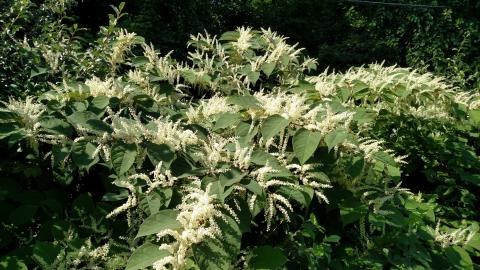When is the best time to control Japanese knotweed?

Japanese knotweed (Reynoutria japonica) is one of the most noxious invasive plants in the northeast. It spreads readily and is very difficult to eliminate from the landscape once it has become established. Those who have Japanese knotweed on their property and are looking to get rid of it are facing a serious challenge. No matter which control method is used, Japanese knotweed management is a marathon, not a sprint.
For those who don’t want to use chemicals, a few techniques have been proven effective. Small, new populations are perhaps easiest to remove by hand pulling or digging. Use a shovel or digging fork at any point during the growing season to loosen the soil around the rhizome and extract the plant. Larger, well-established patches of Japanese knotweed are easier to control by smothering. Smothering is most effective in early summer once the plants have put on a significant amount of growth and have exhausted some of the reserves in their rhizomes. In the beginning of June, cut stems close to the ground and cover them with heavy 7-mil black plastic or non-woven landscape fabric. Put mulch on top of the smothering material to improve its appearance. Smothering can take upwards of five years.
Japanese knotweed can also be effectively controlled with herbicides, but timing is key. The flow of nutrients in Japanese knotweed is in one direction. In the spring and throughout the growing season, sugars and nutrients move upward from the roots to the shoots. In the later summer and fall, the flow reverses, and sugars and nutrients are returned to the plants’ rhizomes in preparation for winter. As a result, chemical applications have been found to be most effective after flowering, and up until the first killing frost. If you’re thinking about controlling Japanese knotweed this fall, it’s a good idea to wait until after the plants are done flowering to limit impacts to pollinators. Japanese knotweed is popular among foraging bees. Before applying any herbicide product, make sure to thoroughly read and follow the label instructions.
Learn more about Japanese knotweed management.
Take a look at our Invasive in the Spotlight article on Japanese knotweed from the spring.
Got questions? The Ask UNH Extension Infoline offers practical help finding answers for your home, yard, and garden questions. Call toll free at 1-877-398-4769, Monday to Friday, 9 a.m. to 2 p.m., or e-mail us at answers@unh.edu.
Related Resource(s)
Do you love learning about stuff like this?
SUBSCRIBE TO Granite State Gardening newsletter
Got questions? The UNH Extension Yard and Garden Infoline offers practical help finding answers for your yard and garden questions.
Call toll free at 1-877-398-4769, Monday to Friday, 9 a.m. to 2 p.m., or fill out webform.

